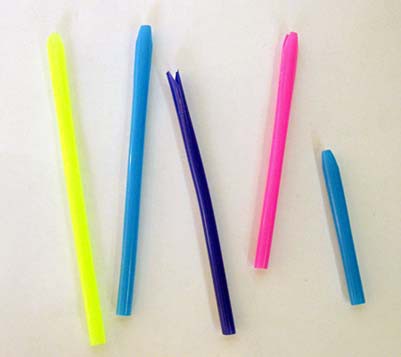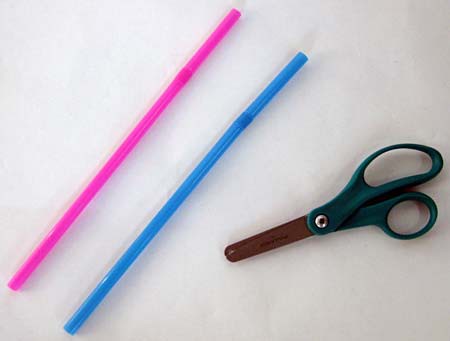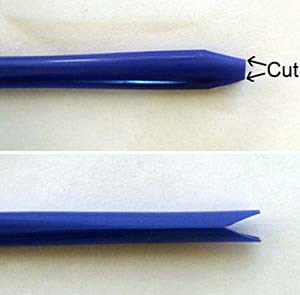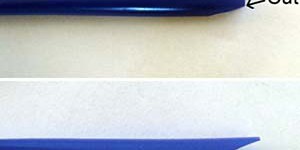Summary

Introduction
Have you ever wondered how a musical instrument produces the beautiful sounds that it does? To make a certain note, the instrument has to make a certain sound wave. Depending on the instrument, the sound wave that is made can be affected by changing the length of part of the instrument, such as the strings in a piano or on a guitar, or a trombone’s air column. In this science activity, you will make your own musical instruments using drinking straws and explore how changing the length of the straws changes the notes that they produce.Materials
- Plastic or paper drinking straws (at least 2)
- Scissors
- Optional: Piano, electronic keyboard, or other musical instrument that can produce a scale of notes
 Image Credit: Teisha Rowland, Science Buddies / Science Buddies
Image Credit: Teisha Rowland, Science Buddies / Science Buddies
Instructions
- Cut one of the two drinking straws so that it is half the length of the other straw
- Take one of the straws and flatten about one inch at one end of the straw. You can use your teeth or pinch it between your fingers or fingernails to flatten it.
- Use scissors to make two, small, angular cuts on each side of the flattened end. This should make the end of the straw be similar to a "V" shape when flattened, but without a pointed tip at the end (the end should have a short, uncut segment left).
- Repeat this to the other straw so that both have small, angular cuts on one end.
 Image Credit: Teisha Rowland, Science Buddies / Science Buddies
Image Credit: Teisha Rowland, Science Buddies / Science Buddies
- Insert the cut end of one of the longer straw into your mouth. Position the cuts so they are just inside your lips. Then curve your lips down and inward a little and apply light pressure on the straw with your lips.
- Blow through the straw. What do you hear? The cut ends should vibrate and produce a tone. You may need to move the straw around slightly to locate the best position for creating your musical note. It may take some practice and repeated tries to produce a constant, single note.
- Now blow through the shorter straw using the same method. Again, you may need to try blowing through the straw a few times to make it produce a constant, single note.What do you hear this time? How does it compare to what you heard with the longer straw?
- If you have a piano, electronic keyboard, or other musical instrument you could try comparing the notes from the straws to the notes on the real musical instrument.Can you figure out which notes the straw are making? Can you tell what the relationship is between the two notes?
What Happened?
Sound travels in invisible waves through the air. The rate at which a sound wave makes the air it travels through vibrate is called the frequency of the sound wave. The higher the frequency, the higher the perceived pitch. The shorter straw should have made a sound wave with a higher frequency than the longer straw, and so the shorter straw should have made a higher pitch than the longer straw.
In fact, because the shorter straw was half the length of the longer straw, the shorter straw should have produced a frequency that was twice the longer straw's frequency. (This is based on a mathematical equation that describes how the frequency produced in an open cylinder is affected by the cylinder's length, where the frequency equals the velocity of sound [which should be constant] divided by two times the cylinder's length. More information about this can be found in this science fair project.) When one sound wave is twice the frequency of another sound wave, the pitches are one octave apart. For example, the musical note middle C has a frequency of 262 Hz, and the C note one octave above this has a frequency of 524 Hz (or two times 262 Hz). However, you may have found that it can take some practice using the straw instruments in this activity to produce a constant, single note.
Digging Deeper
Sound is produced by vibrations of objects. The vibrations push and pull on air molecules, changing the air pressure. The pushes cause a local compression of the air (increase in pressure), and the pulls cause a local rarefaction of the air (decrease in pressure). The compressions and rarefactions are rapidly transmitted through the air (from the original source) as an expanding wave, making sound. Sound itself is a wave, a pattern, of changing air pressures.
For a sound wave, the frequency of the wave corresponds to the perceived pitch of the sound. The higher the frequency, the higher the perceived pitch. Technically, the frequency of a wave describes how many cycles of the wave occur per unit of time. This is measured in hertz (Hz), which is in cycles per second. On average, the frequency range for human hearing is from 20 Hz at the low end to 20,000 Hz at the high end.
On a stringed instrument, like a guitar or piano, when the string is plucked (guitar) or struck (piano), it vibrates and produces a standing wave on the string. These vibrations are transmitted to the soundboard of the instrument, which amplifies the sound.
Ask an Expert
For Further Exploration
- You could try repeating this activity but use eight straws and try to cut them so that each straw produces a note from a scale. For example, for a scale starting with C, these eight notes correspond to the white keys on a piano: C, D, E, F, G, A, B, C. See Science Buddies science fair project Do-Re-Mi with Straws for details on how you could do this. Can you make a scale using eight straws cut to different lengths?
- Other instruments you can construct to easily make multiple notes include soda bottles filled with different amounts of water (and blowing across the tops of them) and goblets filled with different amounts of water (using a clean, slightly wet finger to stroke around the rim of the glass to cause vibrations). How do the notes these instruments produce change when you change how much water is in them? Can you use them to play a scale or a song?








